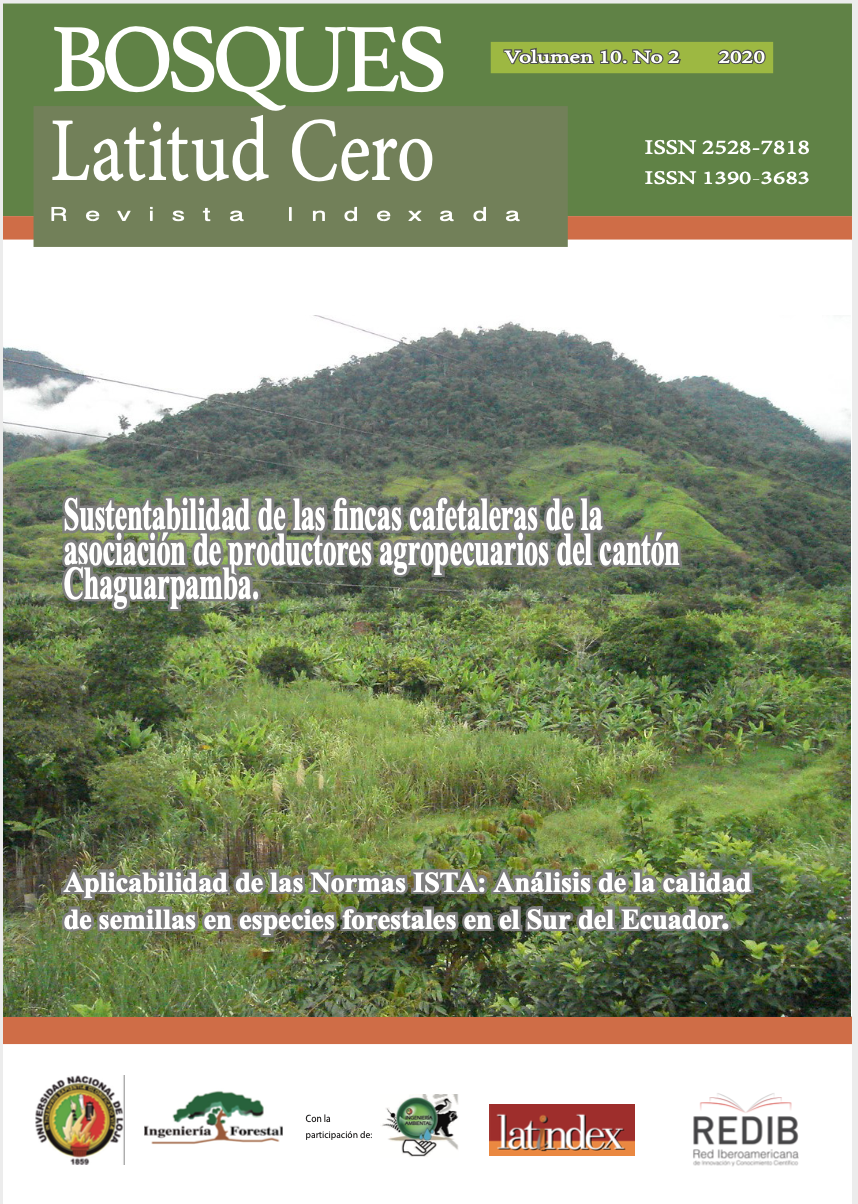Sensitivity of Cinchona officinalis L. to water stress: morphological and wood anatomical changes
Keywords:
lignin, cellulose, morphology, water strees, wood anatomyAbstract
The adaptation and productivity of tree species is directly related to their ability to resist extreme environmental climatic variations. Therefore, the main goal of this is quantify the sensitivity of Cinchona officinalis L. to water stress. In addition, it seeks to identify the main morphological and wood anatomical. For that purpose, 100 seedlings of Cinchona officinalis L. were subjected to water stress treatments within a greenhouse. A vertical incision in the xylem was made as a reference of the beginning of the treatment. After seven months of the experiment (April to October 2019), the morphological changes of all the seedlings were evaluated (height, diameter, phytosanitary status, number of leaves and mortality), and microscopic cross sections in the stem of three seedlings per treatment were made in the Laboratorio de Anatomía de Maderas Tropicales at the UNL to see the anatomical changes and measure the percentages of lignin and cellulose in the xylem. The results showed that Cinchona officinalis L. had a fast recovery of vascular cambium. Water stress decreased its growth up to 55 % in height, 70 % in diameter, 60 % in number of leaves, its phytosanitary status was affected from the third month and mortality reached 10.4 %. In addition, lignin percentages reached up to 74 % in the xylem as a response to water stress. Therefore, for better development, higher levels of humidity and constant watering are essential for the optimal growth of Cinchona officinalis L.References
Acosta-Solís, M. (1946). Cinchonas del Ecuador. Editorial del Ecuador, Quito. 271p.
Acosta, M. (1989). La Cinchona o quina planta nacional del Ecuador. Revista. Académica. Colombia. Ciencia. Volumen 17 (65): 306 – 311 pp.
Amthor JS. (2003). Efficiency and lignin biosynthesis: a quantitative analysis. Annals of Botany. 91(6): 673-695. http://dx.doi.org/10.1093/aob/mcg073. PMid:12714366.
Andersson L (1998) A revision of the genus Cinchona (Rubiaceae-Cinchoneae). Mem N Y Bot Gard 81:1–75
Aranha, K., & León, P. (2013). Área Biológica. “Evaluación de transferencia de microsatélites SSR´s Loci provenientes de otras Rubiáceas a Cinchona officinalis L”. Tesis previa al grado de Bioquímico Farmacéutico. LojaEcuador. 50 p.
Armijos-González, R., & Pérez-Ruiz, C. (2016). In vitro germination and shoot proliferation of the threatened species Cinchona officinalis L (Rubiaceae). Journal of forestry research, 27(6), 1229-1236.
Awad H., Barigah, T., Badela, E., Cochard, H. y Herbette, S. (2010). Poplar vulnerability to xylem cavitation acclimates to drier soil conditions. Physiologia Platarum. 139,280-288.
Barrutia, R. R. R., Barreto, I. B., & Velásquez, T. D. M. (2020). Germination of Cinchona officinalis L. seeds in three soils types of Cajamarca, Peru. Revista Cubana de Ciencias Forestales, 8(1), 75-87.
Buitrón, G. (1999). Uso y Comercio de Plantas Medicinales, Situación actual y Aspectos Importantes para su Conservación. Ecuador: TRAFFIC International. 76 p.
Butz, P., Raffelsbauer, V., Graefe, S., Peters, T., Cueva, E., Hölscher, D., & Bräuning, A. (2017). Tree responses to moisture fluctuations in a neotropical dry forest as potential climate change indicators. Ecological Indicators, 83, 559-571.
Carlquist, S. (1984). Vessel grouping in dicotyledon wood: significance and relationship to imperforate tracheary elements. Aliso 10,505-525.
De Jaegher G, Boyer N, Gaspar TH. Thigmomorphogenesis in Bryonia dioica: changes in soluble and wall peroxidases, phenylalanine ammonia-lyase activity, cellulose, lignin content and monomeric constituents. Plant Growth Regulation 1985; 3(2): 133-148. http://dx.doi.org/10.1007/BF01806053.
DeSoto, L., Cailleret, M., Sterck, F., Jansen, S., Kramer, K., Robert, E. M., ... & Čufar, K. (2020). Low growth resilience to drought is related to future mortality risk in trees. Nature communications, 11(1), 1-9.
Espinosa C, Ríos G (2014) Patrones de crecimiento de Cinchona officinalis in vitro y ex vitro; respuestas de plántulas micropropagadas y de semillas. Rev Ecuat Med Cienc Biol 35(1 y 2):73–82
Feijoo, C., Ramón, D., y Pucha, D. (2018). Guía para cortes anatómicos de la madera. Loja,
Ecuador: EdiLoja.
Garmendia A (2005) El A ´ rbol de la Quina (Cinchona spp.): Distribución, caracterización de su hábitat y arquitectura. Loja, Editorial Universidad Técnica Particular de Loja, p 187.
Hsiao, C. T. y Breadford J. K. (1983). Physiological consequences of cellular water deficits. En : limitations to efficient water use in crop production. Londres. Howard.M. Taylor.
adsen, J. (2002) Historia cultural de la cascarilla de Loja En: Aguirre Z, Madsen J, Cottas E, Balslev H (eds) Botánica Austroecuatoriana: estudios sobre los recursos naturales en las provincias de El Oro, Loja y Zamora Chinchipe. Ediciones AbyaYala. Quito, pp 385–399.
Lima Jiménez, N. R., Moreno Serrano, J. A., Eras Guamán, V. H., Minchala Patiño, J., González Zaruma, D., Yaguana Arévalo, M., & Valarezo Ortega, C. (2018). Propagación in vitro de Cinchona officinalis L a partir de semillas. Revista de Investigaciones Altoandinas, 20(2), 169-178.
Lisar SYS, Motafakkerazad R, Hossain MM, Rahman IMM. (2012). Water stress in plants: causes, effect and responses. In: Rahman IM, Hasegawa H, editors. Water stress. Rijeka: Intech Publishers; 2012.
Lovisolo, C., y Schubert, A. (1998). Effects of water stress on vessel size and xylem hydraulic conductivity in Vitis vinifera L. Journal of experimental botany, 49(321), 693-700.
Malavasi, U. C., Davis, A. S., y Malavasi, M. D. M. (2016). Lignin in woody plants under water stress: a review. Floresta e Ambiente, 23(4), 589-597.
McDowell, N., Pockman, W.T., Allen, C.D., Breshears, D.D., Cobb, N., Kolb, T., Sperry, J., West, A., Williams, D. y Yepez, E.A. (2008). Mechanisms of plant survival and mortality during drought: why do some plants survive while others succumb to drought? Tansley Review. New Phytologist, 178: 719–739.
Miller, G. (2007). Ciencia ambiental: Desarrollo sostenible, un enfoque integral, 8va edición, Editores Internacional Thomson, México.
Montwé, D., Isaac‐Renton, M., Hamann, A., y Spiecker, H. (2016). Drought tolerance and growth in populations of a wide‐ranging tree species indicate climate change risks for the boreal north. Global Change Biology, 22(2), 806-815.
Moura JCMS, Bonine CAV, De Oliveira Fernandes Viana J, Dornelas MC, Mazzafera P. Abiotic and biotic stresses and changes in the lignin content and composition in plants. Journal of Integrative Plant Biology 2010; 52(4): 360-376. http://dx.doi.org/10.1111/j.1744-7909.2010.00892.x. PMid:20377698.
Oliveira, A. K. M., Gualtieri, S. C. J. D., & Bocchese, R. A. (2011). Gas exchange of potted Tabebuia aurea plants under hydric stress. Acta Scientiarum. Agronomy, 33(4), 641-647.
Pan, Y., Birdsey, R., Fang, J., Houghton, R., Kauppi, P., Kurz, W., & Phillips, O. (2011). A large and persistent carbon sink in the world's forests. Science, 333(6045), 988–993.
Sass, U., y Eckstein, D. (1995). The variability of vessel size in beech (Fagus sylvatica L.) and its ecophysiological interpretation. Trees, 9(5), 247-252.
Stephenson, N. L., Das, A. J., Ampersee, N. J., Bulaon, B. M., & Yee, J. L. (2019). Which trees die during drought? The key role of insect host‐tree selection. Journal of Ecology, 107(5), 2383-2401.
Valladares F, Vilagrosa A, Peñuelas J, Ogaya R, Camarero JJ, Corcuera L, Sisó S, Gil-Pelegrín E. 2004. Estrés hídrico: ecofisiología y escalas de la sequía. In: Valladares F, ed. Ecología del bosque Mediterráneo en un mundo cambiante. España: Organismo Autonomo de Parques Nacionales, 165-192.
Warhurst D, Craing J, Adagu I, Meyer D, Lee S (2003) The relationship of physico-chemical properties and structure to the differential antiplasmodial activity of the Cinchona alkaloids. Malar J 2:26.
Downloads
Published
Versions
- 2021-02-24 (3)
- 2021-02-24 (2)
- 2020-12-31 (1)
How to Cite
Issue
Section
License
Copyright (c) 2020 Bosques Latitud Cero

This work is licensed under a Creative Commons Attribution-NonCommercial-ShareAlike 4.0 International License.
This work is published under the Creative Commons Attribution-NonCommercial-ShareAlike 4.0 International (CC BY-NC-SA 4.0) license. This means that users may copy, distribute, and adapt the content, provided that proper credit is given to the authors and the journal. Commercial use of the material is not permitted. Additionally, any derivative work must be distributed under the same license. This license ensures open access to knowledge, promoting the dissemination and reuse of published works for non-commercial purposes, respecting authorship, and ensuring the free circulation of content under fair terms.





























